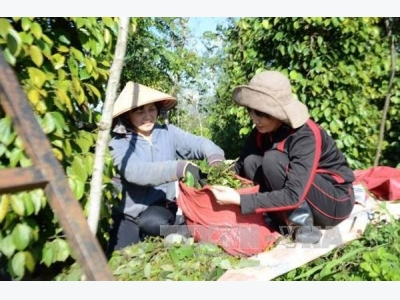Southern provinces face farm labour shortage

Farmers collect pepper in the southern province of Bình Phước. (Photo: VNA)
Dong Nai (VNA) - The south’s key economic provinces, such as Dong Nai, Ba Ria-Vung Tau and Binh Duong, have recently shifted focus from agricultural to non-agricultural sectors, resulting in a serious shortage of agricultural workers during harvest season.
In the last few years, farmers in these provinces have struggled to find seasonal labourers during the harvest of agricultural products such as pepper, cashew and coffee. They said they are willing to pay high wages, but few labourers were available and interested in working the fields.
In Nhon Trach district’s Phuoc Khanh commune in Dong Nai province, sugarcane crops stand ready to be harvested. However, few locals want to do the job.
Le Minh Dung, a seasonal labourer said that he was paid 500,000 VND (22 USD) each day to harvest the sugarcane crops. This is a good payment, but it was a hard job, he said.
Most labourers came from the surrounding provinces, as local young people had left to work in industrial zones, he added.
According to Dung, in order to have labourers work in these sugar cane fields, owners of the fields must deposit a sum of money as a way of booking labourers.
Nguyen Duc Cuong, owner of the 0.5 hectare-pepper garden in Binh Phuoc province’s Thanh Hoa commune, said he needed 10 people to work hard for 10 days to collect all peppers in his garden during the harvest. “We have to pay high to please them. We’ll be dead if they leave,” he said.
He cited that owners of pepper gardens had to pay 200,000-500,000 VND for labourers each day and offered free lunch for them in the recent pepper crop in Bu Dop district.
Vo Van Du, owner of more than 6-hectare pepper garden, said there used to be so many idle laborers in the commune that he just called them several days before the harvest. Now he has to hire labourers to collect his peppers starting in the lunar New Year in February.
“My family members can not pick all the peppers alone. Each sao (360sq.m) needs at least two pickers,” he said.
Le Quoc Viet, chairman of Xuan Loc district’s Farmers Association in Dong Nai province, said that most locals chose to work in industrial zones instead of working in fields, as the work is less hard and offers stable income.
Meanwhile, seasonal labourers from other localities moved when the work called. Therefore, in the harvest time, owners of the crops had no choice but to pay high wages.
Dong Nai is one of top economic provinces in the region, with a strong shift from agricultural to industrial and service sectors. The number of households in rural areas of the province has increased in the past several years, but the proportion of households engaged in agricultural production, forestry and fishery has sharply decreased.
Figures from the province in 2016 showed that there are more than 481,000 households in rural areas. Of those, more than 136,000 households are engaged in agriculture, forestry and fishery – a decrease of over 18,600 households who have moved to the fields of industry, construction and services.
Meanwhile, Ba Ria-Vung Tau province has focused on the marine economy, thanks to the national and international port network. A representative of Chau Duc district’s Division of Agriculture and Rural Development said that the district will allocate a land fund of about 11,000 hectares for non-agricultural purposes.
Of that, more than 3,000 hectares will be used for industrial development, 700 hectares for socio-economic development and the rest for infrastructure development.
Le Van Goi, deputy chief of Dong Nai province’s coordinating office of new rural development programmes, said that the industrialisation of rural areas and the shortage of seasonal labour are unavoidable.
To solve this problem, he suggested that farmers apply science and technology into their agricultural production.
He said to deal with the scarcity of labourers, some households receive bank loans to buy machines that reduce the need for manual labour. Many farmers have invested in installing irrigation systems and purchasing machines for land preparation and harvest.
Pham Minh Dao, former director of the provincial Department of Agriculture and Rural Development, said that the number of machines for agricultural production – more than 9,000 machines and 2,200 harvesters and mills – are still limited compared to the hundreds of thousands of hectares of cultivated land in the province.
He suggested that it was necessary to form specialised farming areas and produce large-field models to reduce costs, increase competitiveness and minimise manual labourers
Related news
 Opportunity to expand the market for Vietnamese vegetables and fruits
Opportunity to expand the market for Vietnamese vegetables and fruits The total value of fruits and vegetables exports of our country has reached 1.02 billion USD, up by nearly 33% over the same period year in 2016.
 Vietnam vows to reorganize coffee production
Vietnam vows to reorganize coffee production With export volume of 1.8 million tons and export turnover of $3.35 billion, coffee was the biggest farm export item in 2016.
 Đà Lạt farmer quit job to grow organic vegetables
Đà Lạt farmer quit job to grow organic vegetables With only basic knowledge of gardening, the master-degree holder put all of his efforts into learning how to grow organic vegetables.